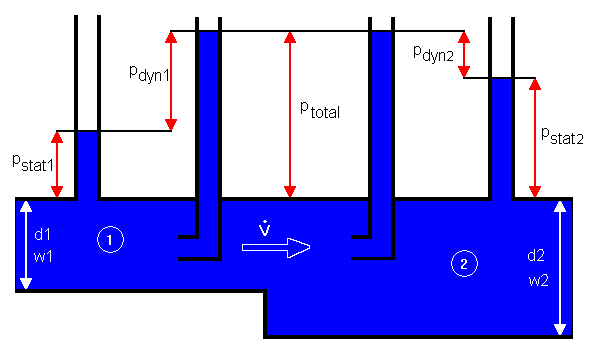Dynamic pressure change - SF Pressure Drop Help
SF Pressure Drop
Help
Principles > Technical terms
Dynamic pressure change
In enlarging or contracting pipes the following pressure changes are
existing:
1. Pressure drop caused by friction, turbulences and flow separation:
dP = resistance coefficient x density/2 x velocity²
dP = resistance coefficient x density/2 x velocity²
2. Pressure change caused by changes of kinetic energy acc. Bernoulli
formula:
dP = density * (velocity1² - velocity2²)/2.
For enlargements the pressure change is positiv, for contractions negativ.
dP = density * (velocity1² - velocity2²)/2.
For enlargements the pressure change is positiv, for contractions negativ.
The element "Dyn. pressure change" calculates the static pressure changes
caused by changes of kinetic energy. Normally you input the dimension of begin
and end of the whole pipe.
Attention: The calculated data are output as pressure drop, i.e. if the
output is negativ the pressure is encreasing, if the output is positiv the
pressure is decreasing.
In previous program versions (< version 6.25) these pressure changes were
calculated in combination with pipe enlargements and contractions.
Correlation: Static pressure, dynamic pressure and total pressure and
calculation example
(Pressure changes caused by friction, turbulences and vertical difference of
pipe are not considered.)

In flows the following pressures are existing:
- static or hydrostatic pressure p_stat
- dynamic or velocity pressure p_dyn
The static pressure is static relative to the moving fluid and can be
measured through a flat opening in parallel to the flow (pressure gauge).
The dynamic pressure is caused by kinetic energy, measurement method
pitot-static tube.
The summary of static and dynamic pressure is the total pressure. It is
measured by a Pitot tube.
According the formula of Bernoulli the sum of static and dynamic pressure is
constant:
p_total1 = p_total2 = constant
p_stat1 + p_dyn1 = p_stat2 + p_dyn2 = constant
Die kinetic energy of the flow is called dynamic or velocity pressure. The
following formula is valid:
p_dyn = density/2 x velocity²
Calculation example: